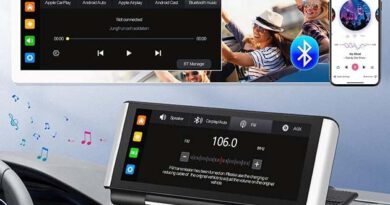Lenovo Legion Go review: 2 things I dislike about this Steam Deck, Nintendo Switch hybrid

Have you ever wanted the Nintendo Switch to be way beefier and more powerful, as well as more expensive? The Lenovo Legion Go might be the device for you.
A couple of those descriptors might sound pejorative, but in truth, Lenovo’s new portable gaming PC (meant to contend with the likes of the Steam Deck and ASUS ROG Ally) is exactly that. As we wait potentially another year for the Switch 2, the Legion Go can whet your appetite with its gigantic, buttery smooth display, detachable controllers, and more than adequate horsepower for running games new, old, indie, and AAA.
Starting at $ 699 for the 512GB model (there’s also an otherwise identical 1TB model for $ 749), it’s certainly not cheap by gaming console standards. But if you want to get a foot into the PC gaming door without committing to a way more expensive laptop or desktop PC, the Legion Go can be an ideal choice for you.
What I love about Lenovo Legion Go

It’s a portable powerhouse
Let’s cut right to the chase: This thing is really good at running all kinds of games. It’s packing an AMD Ryzen Z1 Extreme GPU, which is the same as the high-end ROG Ally model. Since the ROG Ally is widely known to be a bit more powerful than Steam Deck, so too is the Legion Go. It’s also got 16GB of RAM, so it’s plenty capable of multitasking without getting bogged down if need be.
I played a bundle of different games both new and old on the Legion Go and came away fairly impressed by its ability to run them all. Here’s a quick rundown of how my testing went:
-
Burnout Paradise Remastered: A consistent 60 frames per second on high settings
-
Yakuza: Like a Dragon: Around 30FPS on high settings
-
Halo: The Master Chief Collection: A consistent 60FPS on “Performance” settings
-
Halo Infinite multiplayer: A consistent 60FPS on low settings
Of course, nothing in PC gaming ever works perfectly without a little bit of configuration beforehand, and the Legion Go is no different. By default, the device’s screen resolution is set at the maximum 2560×1600 setting. I found that this bogged down performance in games like Like a Dragon, which was nigh-unplayable at that resolution. But bumping it down just a bit to 1920×1200 fixed nearly all the problems I was having without sacrificing much in the way of visual sharpness.

You also have some control over things like fan speed at the device level. Simply press the “Legion R” button (placed roughly where the pause button is on the Switch, at the top of the right controller) to open a quick settings menu. From there, you can change resolution, refresh rate, and thermal and power modes. The latter two can be switched to “Performance,” which makes games more playable at the expense of firing up the internal fan and probably sacrificing some battery life.
Doing all of that, which only takes a few seconds, was what granted me more than acceptable performance levels in every game I tried. I found that things were also slightly better when the Legion Go was plugged into its included AC adapter, but I was able to recreate all of the above performance profiles while unplugged, as well.
Oh, and if it can run all of those AAA games reliably, there shouldn’t be problems with just about any smaller indie games.
A dream Game Pass machine
One of the bigger problems with Valve’s Steam Deck (an otherwise lovely little machine, by all accounts) is that it runs Linux by default. You can install Windows on it, but it requires some effort and some know-how to do it properly. This is not a problem with the Legion Go.

Like the ROG Ally before it, the Legion Go comes with a relatively clean Windows 11 install out of the box. There’s some proprietary Lenovo gaming software that I’ll touch on a little later, but as long as you know your Microsoft account information, you can log in and bring over all your apps and settings from a PC, if you want.
The biggest benefit here from a gaming perspective is that Xbox Game Pass for PC is natively supported on Legion Go. That means more than 400 games are available right away as long as you have a Game Pass subscription. Of course, other platforms like Steam, Epic Games, and GOG are supported as well as they would be on a regular Windows PC. If your library exists in one of those storefronts, you’ll have no trouble accessing it here.
Having options is nice, is all I’m saying.
Big ol’ display
If you accept the argument that the Legion Go’s main two competitors are the Steam Deck and ROG Ally, Lenovo’s device has easily the best display of the three.

It’s not much of a debate, either. Here’s how they stack up:
-
Steam Deck LCD: 7-inch display with 1200×800 resolution and 60Hz refresh rate
-
ROG Ally: 7-inch display with 1920×1080 resolution and 120Hz refresh rate
-
Legion Go: 8.8-inch display with 2560×1600 resolution and 144Hz refresh rate
See? The numbers are higher so that means it’s better. Seriously, though, it’s a big, sharp, vibrant screen that’s great for gaming.
The only caveat here is that Valve just announced an OLED Steam Deck with a bigger 7.4-inch display and a slightly better 90Hz refresh rate. The OLED factor could swing things in Valve’s favor here, but not until the device is in people’s hands and ready for side-by-side testing.
What I dislike about Lenovo Legion Go

Quiet down over there
This one is simple: The fan is pretty loud.
To be more specific, enabling the specific performance settings I enabled to get those games to run as well as they did means you have to deal with fan noise. It’s not at jet engine levels like the original PlayStation 3 or anything, but you can hear it from across a medium-sized room. I would certainly be nervous about bringing it on an airplane if the person sitting next to me didn’t have headphones.
Legion Space kinda stinks
The only reason I called the Legion Go’s version of Windows 11 “relatively clean” is that it comes with a proprietary games library/storefront called Legion Space. This automatically launches on bootup (switching that off in the settings seemingly didn’t fix that, either) and has to be minimized or closed out of entirely before you can get to the apps you actually want to use.

It’s basically just a way for Lenovo to collect every game you have installed across every platform into one little hub, which is nice in theory but not all that great in practice. Personally, if I want to launch something from Steam, I’ll just open Steam. Legion Space’s UI is also full of big, ugly buttons seemingly meant for touchscreen use. I just don’t like the way it looks.
This isn’t a huge dent in the Legion Go’s overall quality, but it is annoying enough to be worth mentioning.
What’s ‘eh’ about Lenovo Legion Go

Controller gimmicks
The last distinguishing factor the Legion Go has over the competition is that the controllers on the left and right sides of the display can be slid off and used separately from the machine, a la the Nintendo Switch Joy-Cons. If you want to game without holding a 1.88lb device in your hands, you can do that.
What’s even more interesting is that there’s a little toggle on the bottom of the right side controller to switch it into “FPS Mode.” The idea is that you place the right controller vertically into an included controller base and use it as a mouse (with the left side acting as a keyboard) for games that benefit from mouse+keyboard controls.
In practice, this works fine but is pretty goofy. You basically slide the controller around on your desk to simulate mouse movement. It’s certainly unique and works exactly as advertised, but it’s not something I’d ever want to do for a long period of time. You might like it, though.

Oh, one other thing to note about the controllers: The analog sticks use what are called “Hall effect sensors.” Without getting too deep into what that means on a technical level, everyone I know who is into that sort of thing tells me that Hall effect sensors are far less likely to succumb to controller drift problems than the sticks that exist on Switch and PS5 controllers. In other words, the Legion Go’s sticks should be much more reliable for a much longer time than any Switch Joy-Con.
Lenovo Legion Go battery life
I wasn’t able to get our usual battery benchmarking software to work on Legion Go, but anecdotally, you can expect to get no more than four hours of continuous use on a single charge, unless you’re playing games that are really not demanding.
It’s not great, but it’s also about in line with what the OG Steam Deck and ROG Ally offer. These are powerful machines and the technology to give them long battery life without making compromises in size and price just may not exist yet. In terms I and many others can understand, you might be able to play the Legion Go while watching a football game on your TV, but probably not for any longer than that.
How well does Cyberpunk 2077 run on Lenovo Legion Go?

Last but certainly not least, let’s talk about how the Legion Go handles one of gaming’s most famously demanding titles: Cyberpunk 2077.
Nearly three years after launch, Cyberpunk’s bugs have largely been ironed out and the game is now genuinely pretty good. However, it’s still very taxing on any machine you play it on. Running the in-game benchmarking tool on the “Steam Deck” settings preset (which includes high texture quality, among other things), the Legion Go averaged 40FPS. The same benchmark on a Steam Deck proper came out to about 30FPS.
Not only is Cyberpunk fully playable on a Legion Go, it might even be downright enjoyable. How about that?
Final thoughts
With the qualifier that the Steam Deck OLED isn’t out just yet, I don’t think it’s crazy to say the Legion Go might be pound-for-pound the best one of these handheld gaming PCs to date.
Its performance profile speaks for itself, while the display is a good deal better than the original Steam Deck and the ROG Ally. A basic version of Windows 11 means you can do pretty much whatever you want with the device, even while dealing with the irksome Legion Space software. The detachable controllers are also neat in theory, though I’m not the kind of person who would ever get use out of them.
At $ 699, it’s not exactly cheap, but it’s easily one of the better entryways into PC gaming you can get right now.


